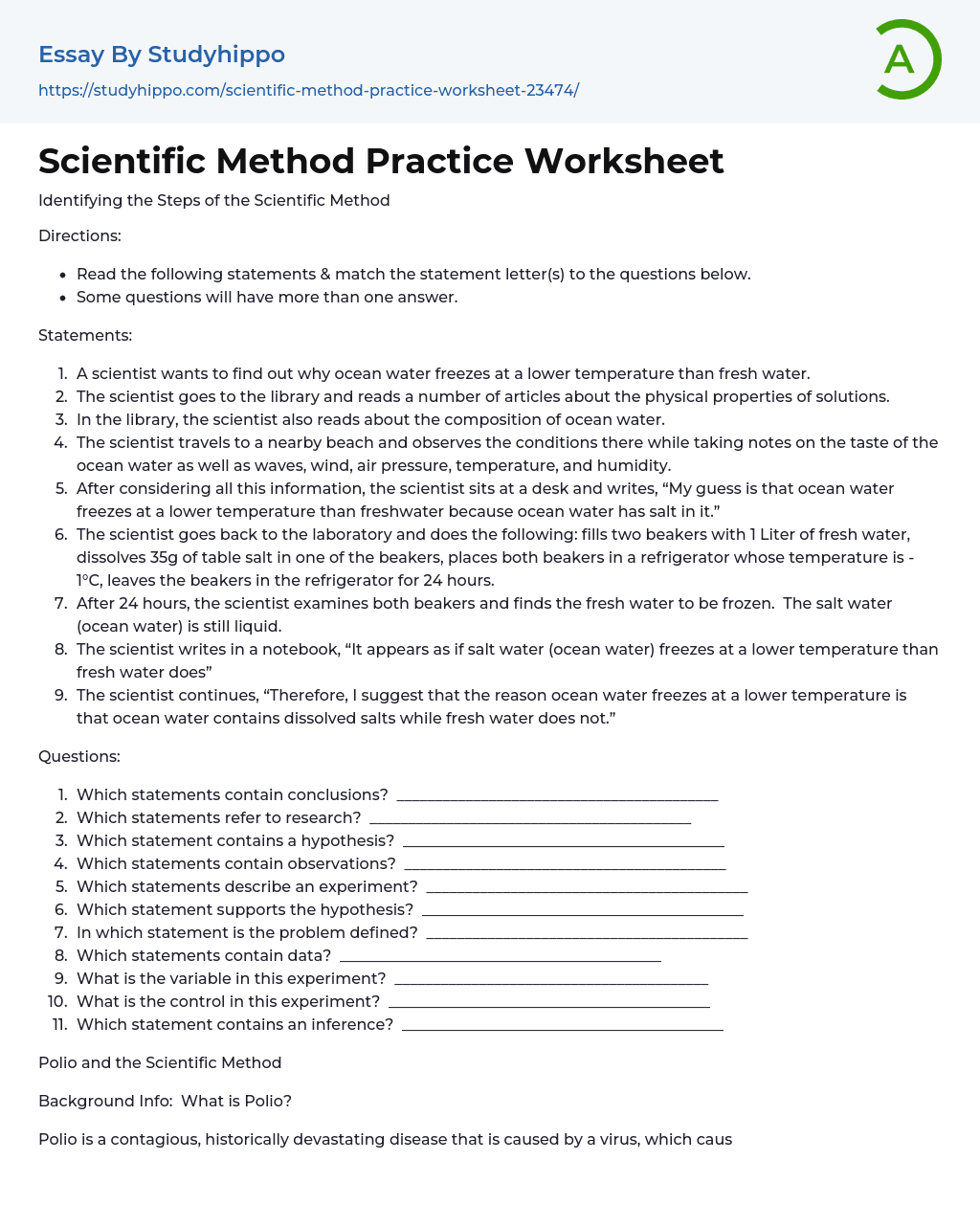Identifying the Steps of the Scientific Method
Directions:
- Read the following statements & match the statement letter(s) to the questions below.
- Some questions will have more than one answer.
Statements:
- A scientist wants to find out why ocean water freezes at a lower temperature than fresh water.
- The scientist goes to the library and reads a number of articles about the physical properties of solutions.
- In the library, the scientist also reads about the composition of ocean water.
- The scientist travels to a nearby beach and observes the conditions there while taking notes on the taste of the ocean water as well as waves, wind, air pressure, temperature, and humidity.
- After considering all this information, the scientist sits at a desk and writes, “My guess is that ocean water freezes at a lower temperature than freshwater because ocea
...n water has salt in it.”
- The scientist goes back to the laboratory and does the following: fills two beakers with 1 Liter of fresh water, dissolves 35g of table salt in one of the beakers, places both beakers in a refrigerator whose temperature is -1°C, leaves the beakers in the refrigerator for 24 hours.
- After 24 hours, the scientist examines both beakers and finds the fresh water to be frozen. The salt water (ocean water) is still liquid.
- The scientist writes in a notebook, “It appears as if salt water (ocean water) freezes at a lower temperature than fresh water does”
- The scientist continues, “Therefore, I suggest that the reason ocean water freezes at a lower temperature is that ocean water contains dissolved salts while fresh water does not.”
Questions:
- Which statements contain conclusions? __________________________________________
- Which statements refer to research?�
View entire sampleJoin StudyHippo to see entire essay
__________________________________________
Polio and the Scientific Method
Background Info: What is Polio?
Polio is a contagious, historically devastating disease that is caused by a virus, which causes muscles not to work and attacks the nervous system of the human body. If left untreated, polio can eventually lead to death. People who have abortive polio or non-paralytic polio usually make a full recovery. However, paralytic polio, as its name implies, causes muscle paralysis - and can even result in death. In paralytic polio, the virus leaves the intestinal tract and enters the bloodstream, attacking the nerves (in abortive or asymptomatic polio, the virus usually doesn't get past the intestinal tract). The virus may affect the nerves governing the muscles in the limbs and the muscles necessary for breathing, causing respiratory difficulty and paralysis of the arms and legs.
Although polio has plagued humans since ancient times, its most extensive outbreak occurred in the first half of the 1900s before the vaccination, created by Jonas Salk, became widely available in 1955. At the height of the polio epidemic in 1952, nearly 60,000 cases with more than 3,000 deaths were reported in the United States alone. However, with widespread vaccination, wild-type polio, or polio occurring through natural infection, was eliminated from the United States by 1979 and the Western hemisphere by 1991.
Scenario:
In the early 1950’s,
nearly 60,000 people were stricken with Polio. Hundreds of medical researchers were trying to find an effective way to prevent this dreaded disease. Among them was Dr. Jonas Salk. Salk investigated various methods on how to eliminate this virus and decided to produce a vaccine. He developed several different types of vaccines and tested them in experiments on monkeys. As a result of his experiments he developed a working vaccine that contained the “inactive” polio virus. After perfecting this vaccine in the laboratory, Salk tested it on several hundred people and found it to be safe. The next step was to test this new vaccine on a larger scale. In a nationwide field test in 1954, over 440,000 children were vaccinated with Salk’s vaccine. Like any good test, half the children were unknowingly given the real vaccine while the other half unknowingly received a “fake” vaccine called a placebo. A placebo acts like a control in an experiment. These tests, and additional tests in Canada and Denmark, showed the vaccine to be nearly 100% effective.
Background Questions:
- What is Polio?
- When was polio eliminated from the United States?
- When was Polio eliminated form the Western hemisphere?
Scenario Questions:
- What was the problem in the scenario above?
- What were the test subjects in the beginning stages of the various experimental vaccines?
- What was in the final working vaccine that Salk chose to try?
- How did he first test his new working vaccine?
- How did he verify the results of his first test?
- What is a placebo?
- Why was a control used in the experiment?
;
- Cloning essays
- Medical Ethics essays
- Patient essays
- Therapy essays
- drugs essays
- Cannabis essays
- Aspirin essays
- Cardiology essays
- Hemoglobin essays
- Pharmacology essays
- Surgery essays
- alternative medicine essays
- Plastic Surgery essays
- Organ Donation essays
- Vaccines essays
- Medical essays
- Dentist essays
- Psychological Trauma essays
- Physical therapy essays
- Cold essays
- Cocaine essays
- Why Marijuana Should Be Legalized essays
- Drug Abuse essays
- Teenage Drug Abuse essays
- Heart Disease essays
- Artery essays
- Research Methods essays
- Experiment essays
- Hypothesis essays
- Observation essays
- Qualitative Research essays
- Theory essays
- Explorer essays
- Bottled Water essays
- Addiction essays
- Anatomy and Physiology essays
- Biodegradation essays
- Cancer essays
- Dental Care essays
- Disability essays
- Disease essays
- Disorders essays
- Health Care essays
- Infectious Disease essays
- Inquiry essays
- Intelligence Quotient essays
- Lung Cancer essays
- Medicine essays
- Neurology essays
- Nutrition essays




